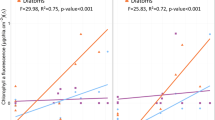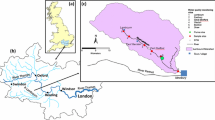Abstract
After indications from the literature that nutrient concentrations may modify the toxicity of herbicides to natural periphyton communities, this study aims to provide experimental proof for atrazine. In this microcosm experiment, phosphate (P) addition did not ameliorate atrazine toxicity to periphyton. Three weeks of P addition did not increase atrazine tolerance (measured as EC50 in acute toxicity tests), whereas exposure to atrazine under conditions that were either P-limited or non-P-limited clearly reduced the development of algal biomass. Long-term exposure to atrazine induced tolerance of the community to the herbicide, and this was not influenced by P addition. Tolerance induction in this microcosm experiment has been compared with previously published field data from the same area of study and indicates that tolerance induction by atrazine may take place under atrazine exposure in streams as well as in microcosms.


Similar content being viewed by others
References
Barreiro R, Pratt JR (1994) Interaction of toxicants and communities: the role of nutrients. Environ Toxicol Chem 13:361–368
Battah MG, Shabana EF, Kobbia IA, Heladle HM (2001) Differential effects of thiobencarb toxicity on growth and photosynthesis of Anabaena variabilis with changes in phosphate level. Ecotoxicol Environ Saf 49:235–239
Berard A, LeboulangerC, Pelte T (1999) Tolerance of Oscillatoria limnetica Lemmermann to atrazine in natural phytoplankton populations and in pure culture: influence of season and temperature. Arch Environ Contam Toxicol 37:472–479
Brown LS, Lean DRS (1995) Toxicity of selected pesticides to lake phytoplankton measured using photosynthesis inhibition compared to maximal uptake rates of phosphate and ammonium. Environ Toxicol Chem 14:93–98
DeLorenzo ME, Lauth J, Pennington PL, Scott GI, Ross PE (1999) Atrazine effects on the microbial food web in tidal creek mesocosms. Aquat Toxicol 46:241–251
Detenbeck NE, Hermanutz R, Alien K, Swift MC (1996) Fate and effects of the herbicide atrazine in flow-through wetland mesocosms. Environ Toxicol Chem 158:937–946
Ekholm P, Kallio K, Salo S, Pietilanen OP, Rekolainen S, Laine Y, Joukola M (2000) Relationship between catchment characteristics and nutrient concentrations in an agricultural river system. Water Res 15:3709–3716
Graymore M, Stagnitti F, Allison G (2001) Impacts of atrazine in aquatic ecosystems. Environment Int 26:483–495
Guasch H, Muñoz I, Rosés N, Sabater S (1997) Changes in atrazine toxicity through succession of stream periphyton communities. J Appl Phycol 9:137–146
Guasch H, Ivorra N, Lehmann V, Paulsson M, Real M, Sabater S (1998) Community composition and sensitivity of periphyton to atrazine in flowing waters: the role of environmental factors. J Appl Phycol 10:203–213
Guasch H, Admiraal W, Sabater S (2003) Contrasting effects of organic and inorganic toxicants on freshwater periphyton. Aquat Toxicol 64:165–175
Guasch H, Navarro E, Serra A, Sabater S (2004) Phosphate limitation influences the sensitivity to copper in periphytic algae. Freshwat Biol 49:463–473
Huber W (1993) Ecotoxicological relevance of atrazine in aquatic systems. Environ Toxicol Chem 12:1865–1881
Ivorra N, HettelaarJ, Tubbing GMJ, Kraak MHS, Sabater S, Admiraal W (1999) Translocation of microbenthic algal assemblages used for in situ analysis of metal pollution in rivers. Arch Environ Contam Toxicol 37:19–28
Ivorra N, Hettelaar J, Kraak MHS, Sabater S, Admiraal W (2002) Responses of biofilms to combined nutrient and metal exposure. Environ Toxicol Chem 21:626–632
Jeffrey SW, Humphrey GF (1975) New spectophotometric equations for determining cholophylls a, b, c1 and c2 in higher plants, algae and natural phytoplankton. Bioch Physiol Pflanz 167:191–194
Mohapatra PK, Mohanty RC (1992) Differential effect of dimethoate toxicity to Anabaena doliolum with change in nutrient status. Bull Environ Contam Toxicol 48:223–229
Murphy J, Riley JP (1962) A modified single solution for the determination of phosphate in natural waters. Anal Chim Acta 27:31–36
Nyström B, Paulsson M, Almgren K, Blank H (2000) Evaluation of the capacity for developement of astrazine tolerance in peripyton from a Swedish freshwater site as determined by inhibition of photosynthesis and sulfolipid synthesis. Env Toxicol Chem 19:1324–1331
Paulsson M (2000) Variability in lotic periphyton communities tolerance to zinc and atrazine, in relation to bioavailability. PhD, Göteborg University, 213 pp
Paulsson M, Mansson V, Blanck H (2002) Effects of zinc on the phosphorus availability to periphyton from the Göta Älv. Aquat Toxicol 56:103–113
Pereira WE, Hostettler FD (1993) Nonpoint source contamination of the Mississippi River and its tributaries by herbicides. Environ Sci Technol 27:542–1552
Pratt JR, Barreiro R (1998) Influence of trophic status on the effect of a herbicide: a microcosm study. Arch Environ Contam Toxicol 35:404–411
Ronday R, Aalderink GH, Crum SJH (1998) Application methods of pesticides to aquatic mesocosms in order to simulate effects of spray drift. Water Res 32:147–153
Seguin F, Le Bihan F, Leboulanger C, Bérard A (2002) A risk assessment of pollution: induction of atrazine tolerance in phytoplankton communities in freshwater outdoor mesocosms, using chlorophyll fluorescence as an endpoint. Water Res 36:3227–3236
Shabana EF, Battah MG, Kobbia IA, Eladen HM (2001) Effect of pendimethalin on growth and photosynthetic activity of Protosiphon botryoides in different nutrient states. Ecotoxicol Environ Saf 49:106–110
Solomon K, Baker D, Richards R, Dixon K, KIaine S, La Point T (1994) Ecological risk assessment of atrazine in North American surface waters. Environ Toxicol Chem 15:31–76
Winer BJ (1971) Statistical principles in experimental design. MaGraw Hill, New York, 907 pp
Weiner JA, DeLorenzo ME, Fulton MH (2004) Relationship between uptake capacity and differential toxicity of the herbicide atrazine in selected microalgal species. Aquatic Toxicol 68:121–128
Acknowledgments
This research was performed within the framework of the EC (1996/99) project “Microbenthic Communities in European Rivers Used to Assess Effects of Land-Derived Toxicants” ENV4-CT96-0298 and the Spanish Ministry of Science and Technology project “Dynamics of toxic substances in river ecosystems: effects on river biofilms and consequences for water quality” REN2003-0772.
Author information
Authors and Affiliations
Corresponding author
Rights and permissions
About this article
Cite this article
Guasch, H., Lehmann, V., van Beusekom, B. et al. Influence of Phosphate on the Response of Periphyton to Atrazine Exposure. Arch Environ Contam Toxicol 52, 32–37 (2007). https://doi.org/10.1007/s00244-005-0186-5
Received:
Accepted:
Published:
Issue Date:
DOI: https://doi.org/10.1007/s00244-005-0186-5




